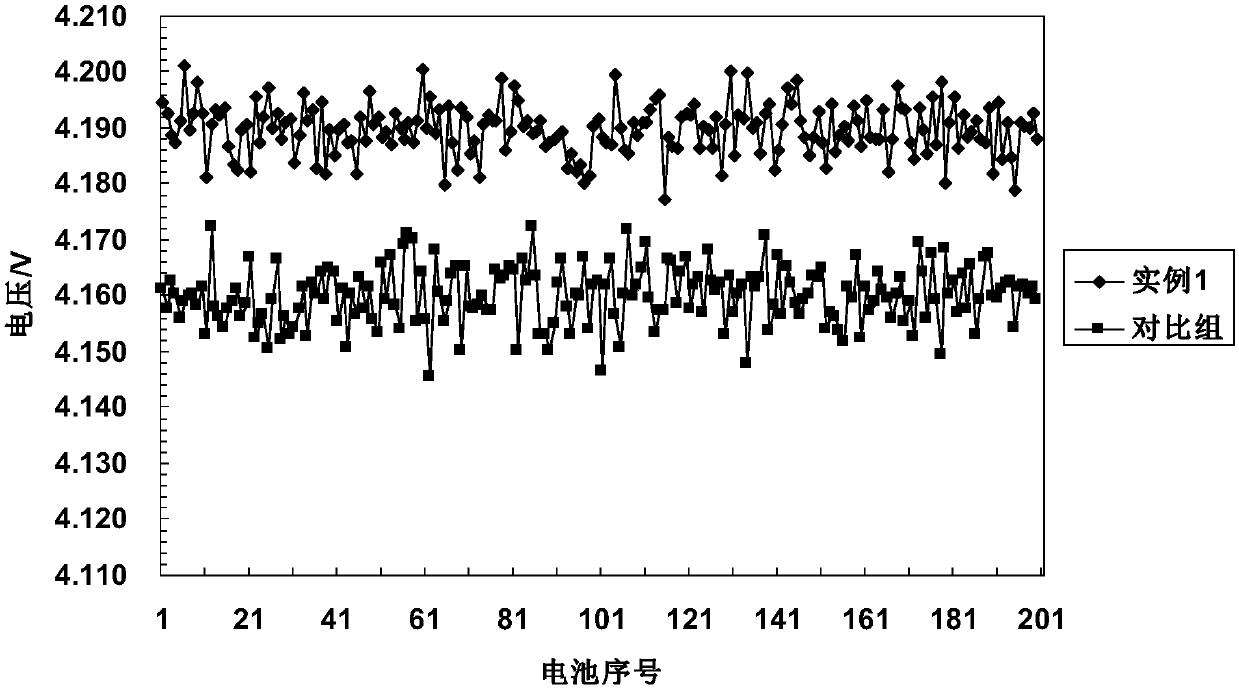A kind of capacity division method of high-voltage lithium-ion battery
A lithium-ion battery and capacity-division technology, which is applied in secondary batteries, electrolyte battery manufacturing, non-aqueous electrolyte batteries, etc., to achieve the effects of eliminating insufficient power supply, stable voltage and slow decay.
- Summary
- Abstract
- Description
- Claims
- Application Information
AI Technical Summary
Problems solved by technology
Method used
Image
Examples
Embodiment 1
[0026] A kind of capacity dividing method of high-voltage lithium-ion battery, its concrete steps are as follows:
[0027] a. The first charging stage: take the formed battery, charge it to 4.2V with a current of 0.5C constant current and constant voltage, the cut-off current is 0.02C, the time limit is 130min, and stand for 5min;
[0028] b. Discharge stage: Discharge to 3.0V at a constant current of 0.5C, the time limit is 130min, and stand for 5min;
[0029] c. The second charging stage: charge to 4.2V with a current of 0.5C constant current and constant voltage, the cut-off current is 0.02C, the time limit is 200min, and stand for 60min;
[0030] d. The third charging stage: first charge to 4.21V with a current of 0.5C constant current and constant voltage, the cut-off current is 0.02C, the time limit is 60min, and stand for 60min; then charge to 4.22V with a current of 0.5C constant current and constant voltage V, the cut-off current is 0.02C, the time limit is 60min, an...
Embodiment 2
[0033] A kind of capacity dividing method of high-voltage lithium-ion battery, its concrete steps are as follows:
[0034] a. The first charging stage: take the formed battery, charge it to 4.0V with a current of 0.05C constant current and constant voltage, the cut-off current is 0.02C, the time limit is 150min, and stand for 5min;
[0035] b. Discharge stage: discharge to 3.0V at a constant current of 0.05C, the time limit is 150min, and stand for 5min;
[0036] c. The second charging stage: charge to 4.2V with a current of 1.0C constant current and constant voltage, the cut-off current is 0.02C, the time limit is 180min, and stand for 60min;
[0037] d. The third charging stage: first charge to 4.21V with a current of 0.05C constant current and constant voltage, the cut-off current is 0.02C, the time limit is 120min, and stand for 60min; then charge to 4.22V with a current of 0.5C constant current and constant voltage V, the cut-off current is 0.02C, the time limit is 60min...
Embodiment 3
[0040] A kind of capacity dividing method of high-voltage lithium-ion battery, its concrete steps are as follows:
[0041] a. The first charging stage: take the formed battery, charge it to 4.2V with a current of 0.05C constant current and constant voltage, the cut-off current is 0.02C, the time limit is 150min, and stand for 5min;
[0042] b. Discharge stage: discharge to 3.0V at a constant current of 0.05C, the time limit is 180min, and stand for 5min;
[0043] c. The second charging stage: charge to 4.2V with a current of 0.5C constant current and constant voltage, the cut-off current is 0.02C, the time limit is 200min, and stand for 60min;
[0044]d. The third charging stage: first charge to 4.21V with a current of 0.05C constant current and constant voltage, the cut-off current is 0.02C, the time limit is 120min, and stand for 60min; V, the cut-off current is 0.02C, the time limit is 120min, and the time is limited to 60min; first charge to 4.23V with a current of 0.5C c...
PUM
 Login to View More
Login to View More Abstract
Description
Claims
Application Information
 Login to View More
Login to View More - R&D
- Intellectual Property
- Life Sciences
- Materials
- Tech Scout
- Unparalleled Data Quality
- Higher Quality Content
- 60% Fewer Hallucinations
Browse by: Latest US Patents, China's latest patents, Technical Efficacy Thesaurus, Application Domain, Technology Topic, Popular Technical Reports.
© 2025 PatSnap. All rights reserved.Legal|Privacy policy|Modern Slavery Act Transparency Statement|Sitemap|About US| Contact US: help@patsnap.com

